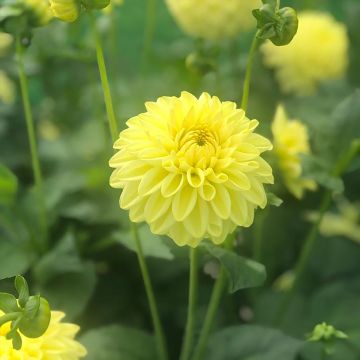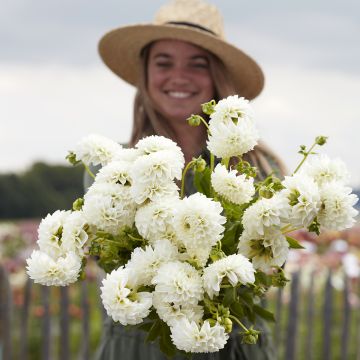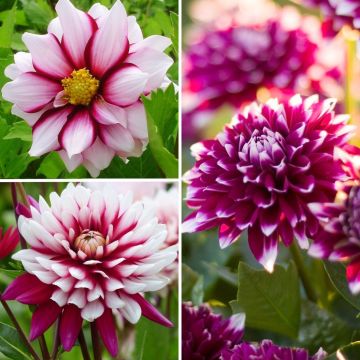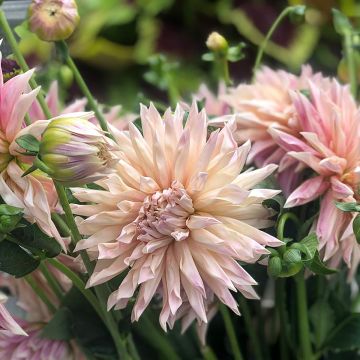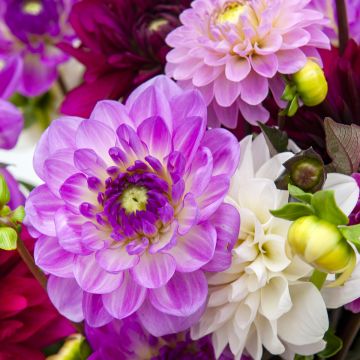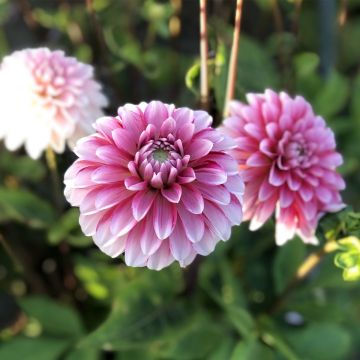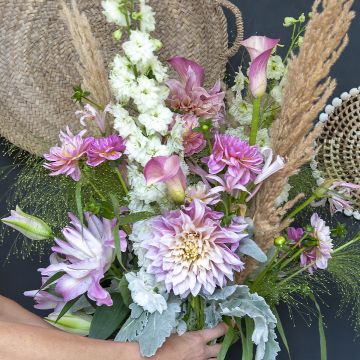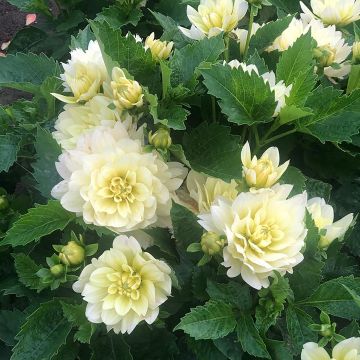
Succeeding with your dahlias
All our tips for planting and caring for them
Contents
Dahlias are appreciated for their large flowers that come in a wide range of colours and shapes. There is something for everyone: some offer simple flowers with a very natural style, while others stand out with their sophisticated blooms (ball dahlias, cactus dahlias…). Whether you prefer dwarf varieties to dress your borders or giant dahlias that majestically dominate your beds, these plants provide generous and prolonged flowering, from mid-summer until the first frosts.
Easy to grow, dahlias adapt to many garden styles, whether they are rustic, modern, or romantic. They are perfect for creating colourful beds, alongside perennials or other summer-flowering bulbs. Discover all our tips for successfully growing them and enjoy their splendid flowering!
When to plant dahlias?
The ideal time to plant your dahlias depends on the climate of your region. In cold regions, wait until the end of the last frosts, usually late April or early May, to plant them in the ground. Young dahlias are sensitive to cold, so it is essential not to rush.
If you have purchased bulbs packaged in bags, don’t worry: they can patiently wait until the right planting time. Just make sure to keep them in a dry, dark place protected from frost, such as an unheated cellar or garage. Good ventilation is also important to prevent the development of mould.
For regions with a milder climate, it is possible to plant dahlias as early as mid-March. In any case, ensure that the soil is well warmed (at least 10 °C) to encourage quick and vigorous growth.
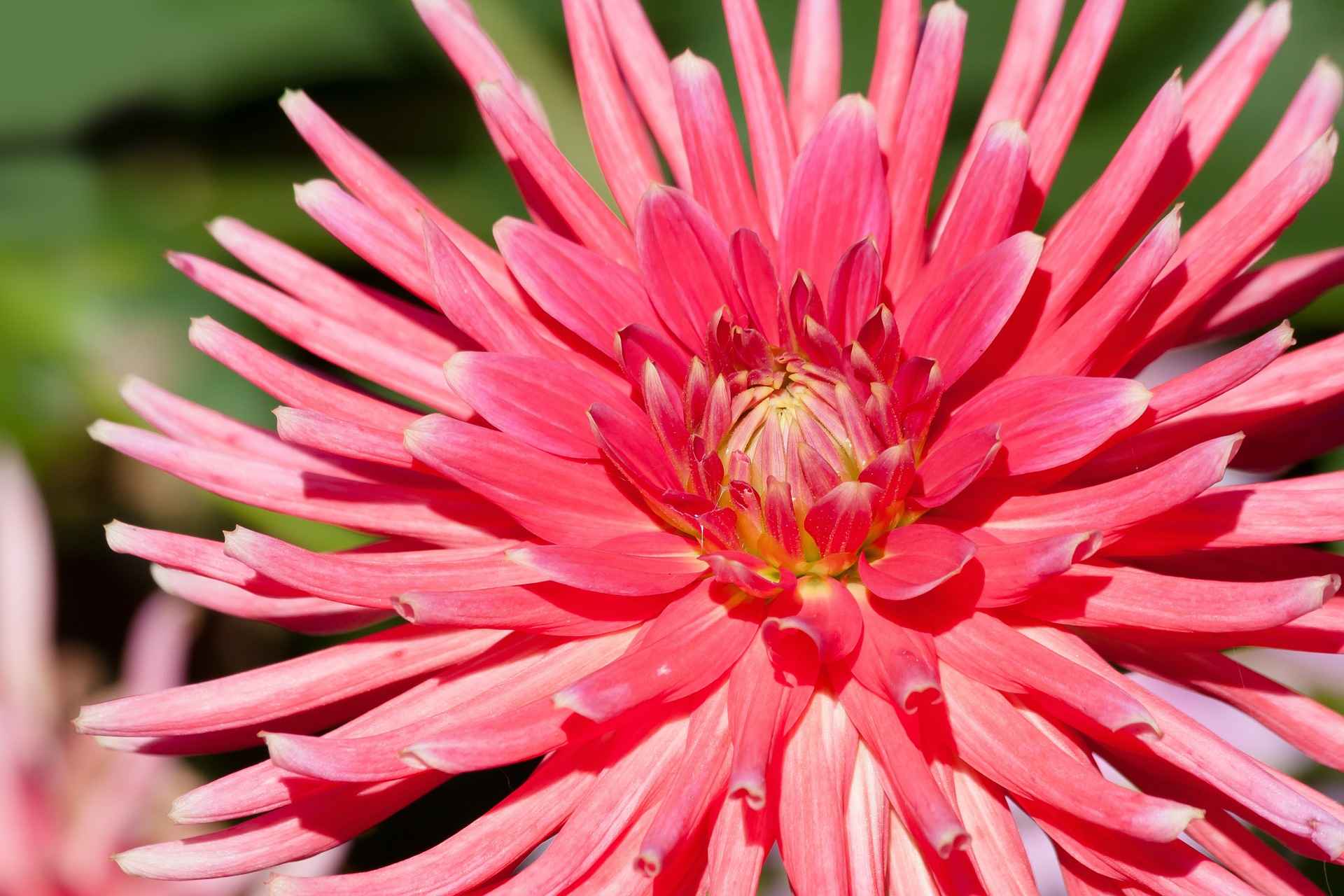
Read also
Dahlia: planting, care, and growing tipsHow to force dahlias?
If you want your dahlias to flower earlier in the season, it is possible to force them by initiating growth before planting them outdoors. This technique allows you to gain several weeks on their flowering, ideal for a vibrant garden from the beginning of summer.
To do this, if you have a greenhouse, a bright conservatory, or cold frames, follow these steps:
- Fill pots with rich, slightly moist potting soil.
- Plant your dahlia tubers at a shallow depth, just covered with a thin layer of potting soil. Ensure that the “eyes” (the buds on the tubers) are facing upwards.
- Place the pots in a bright location, protected from frost, with a temperature ideally between 15 and 18 °C.
- Water lightly to maintain constant moisture, but without saturating the substrate. Within a few weeks, the tubers will start to produce roots and young shoots.
When the risk of frost has completely passed, usually in mid-May, you can transplant your dahlias outdoors, taking care to preserve the clumps that have already formed. This will allow them to continue their growth without interruption, ensuring a quick and vigorous start in the garden.
Tip: If your dahlias are growing a bit too quickly or becoming too tall before transplanting, pinch back the young shoots slightly to encourage branching and even more abundant flowering!
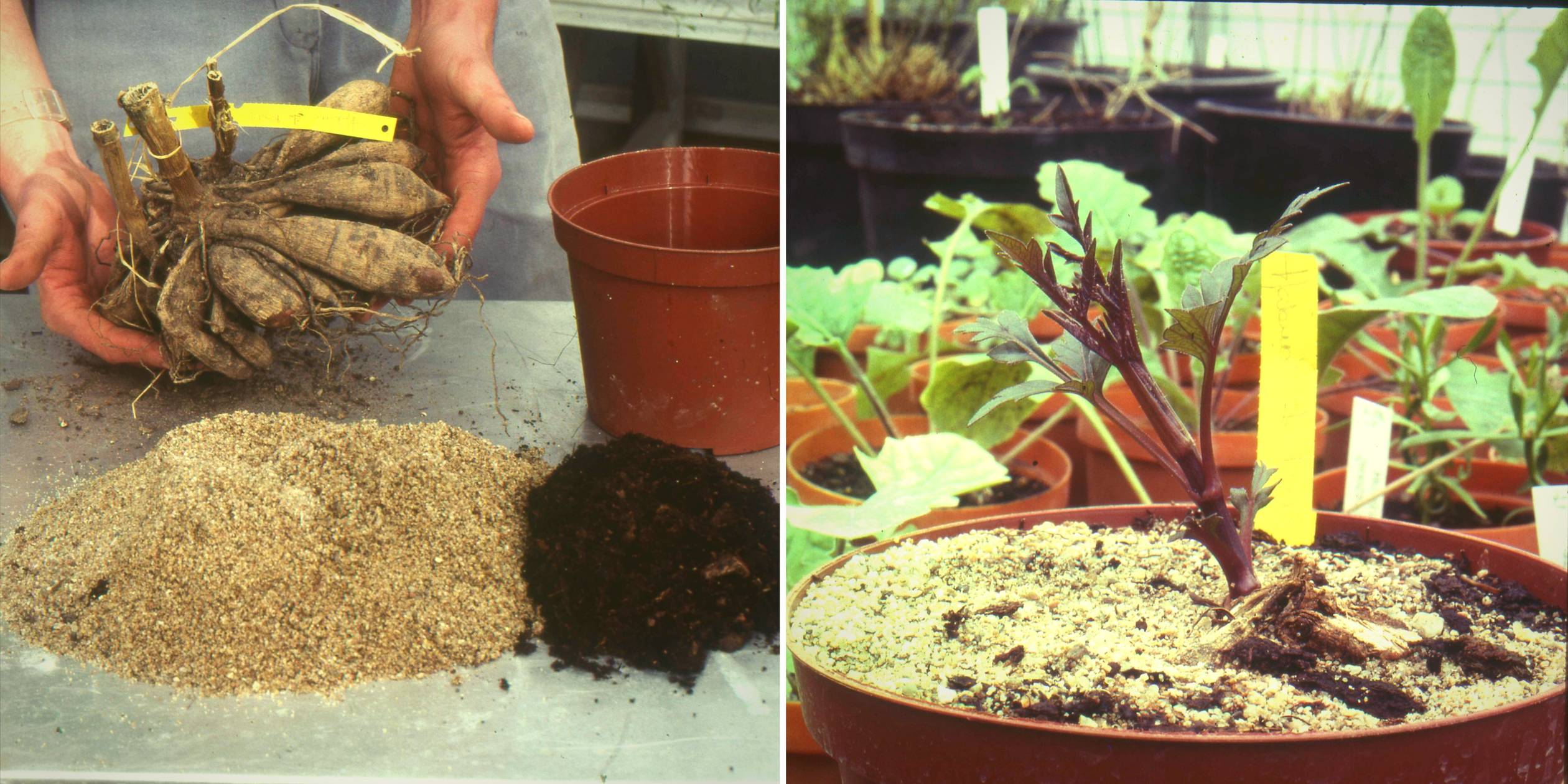
Discover other Dahlias
View all →Available in 1 sizes
Available in 1 sizes
Available in 0 sizes
Available in 1 sizes
Available in 1 sizes
Available in 0 sizes
Available in 1 sizes
Available in 0 sizes
Available in 1 sizes
Available in 1 sizes
Where to plant dahlias?
Dahlias thrive in sunny, sheltered locations, which are essential for ensuring abundant flowering and robust plants. Ideally, choose a spot that receives at least six hours of direct sunlight per day, as a lack of light could reduce flower production and make the stems more fragile.
Dahlias prefer rich, well-drained soil that is slightly acidic to neutral. Soil that is too compact or waterlogged may cause the tubercles to rot. If your soil is heavy or clayey, improve it by adding sand, well-decomposed compost, or potting mix to enhance aeration and drainage.
Dahlias integrate beautifully into mixed borders, where their colourful flowers can be showcased alongside other perennial plants or annuals. Low-growing varieties are perfect for borders or pot cultivation, ideal for decorating terraces and balconies. As for tall varieties, they stand out in the background or as a focal point in a border.
How to plant dahlias?
Planting dahlias is a key step to ensure a generous and lasting flowering. Here are the steps to follow to properly install them in your garden:
- Dahlias appreciate rich, well-drained soil. Work the soil to a depth and width of about 20 cm to aerate it and facilitate rooting. Mix in a handful of roasted horn powder or dried blood, which will serve as slow-release organic fertiliser. Crumble the soil well to eliminate clumps.
- Dig a planting hole wide enough to accommodate the tuber. Pour about 1 litre of water at the bottom of the hole to moisten the area without saturating the soil.
- Place the tuber in the hole, with the “eyes” (buds) facing upwards. Cover it with about 8 cm of fine soil to protect the tuber while leaving enough space for the young shoots to emerge easily.
- If planting a tall variety, insert a sturdy stake next to the tuber at planting time. This will prevent damaging the roots or tubers later when the plant has grown.
- For the tallest varieties, maintain a distance of 80 cm to 1 m to allow them to flourish without being crowded. For shorter dahlias, plan for 30 to 50 cm between each plant. These compact varieties are particularly well-suited for borders or small spaces.
- When your dahlias start to grow, a balanced fertiliser every 3 to 4 weeks will promote their growth and flowering. Also, mulch around the base to retain moisture and limit weeds.
Tip for pot cultivation:
Short varieties of dahlias are ideal for terraces and balconies. Use large pots with good drainage filled with quality potting soil enriched with compost. Water regularly to maintain consistent moisture, and add a liquid fertiliser every 15 days during the flowering period.
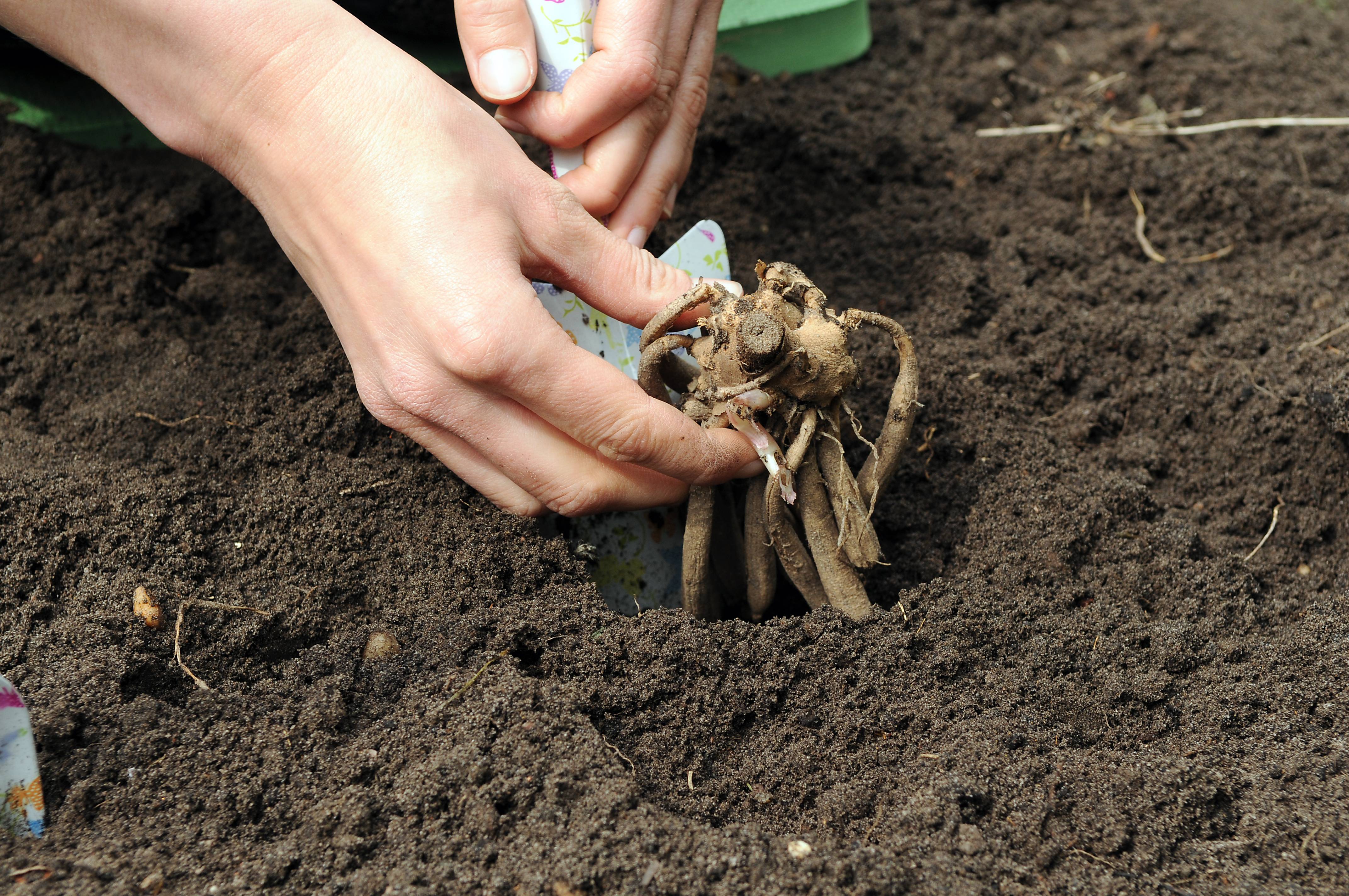
How to care for them?
Once the dahlias have resumed their growth well, we advise you to mulch the soil around the plants. Mulching helps retain moisture, limits the proliferation of weeds, and protects the tubercles from temperature fluctuations. Opt for natural materials such as straw or wood chips.
The young shoots of dahlias are often targeted by slugs and snails, particularly in early spring. To prevent these attacks, you can install natural barriers around the plants, such as crushed eggshells, or use eco-friendly solutions like beer traps or suitable pellets. Increased vigilance at this stage of their growth is essential to avoid irreversible damage.
Some varieties of dahlias (the taller ones, as well as those that produce large flowers) require staking. Installing the stakes at planting time prevents damage to the tubercles. Gently tie the stems using soft ties to ensure they are well supported against the wind or the weight of the flowers.
Throughout the flowering period, remember to regularly remove faded flowers to stimulate the appearance of new blooms. Prune the stems just above a node to encourage branching and prolong flowering.
If you wish to achieve a bushier and more branched habit, pinch the main stem when the plant reaches about 15 to 20 cm in height. This technique promotes the production of new stems and, consequently, a greater number of flowers. For those who prefer larger flowers, it is possible to remove the lateral flower buds so that the plant concentrates its energy on the main bud.
Water your dahlias deeply once or twice a week, adjusting the frequency according to the weather and the nature of the soil. However, avoid wetting the foliage, as this could promote diseases such as powdery mildew. To prolong flowering and strengthen the plants, a balanced fertiliser for flowering plants is recommended every three to four weeks.
Finally, it is important to regularly monitor your dahlias for any potential problems, such as diseases or pest attacks. In case of spots or discolouration on the foliage, treat promptly with natural solutions, such as horsetail manure, or suitable products. With these few attentions, your dahlias will provide you with an explosion of colour and vitality throughout the summer.
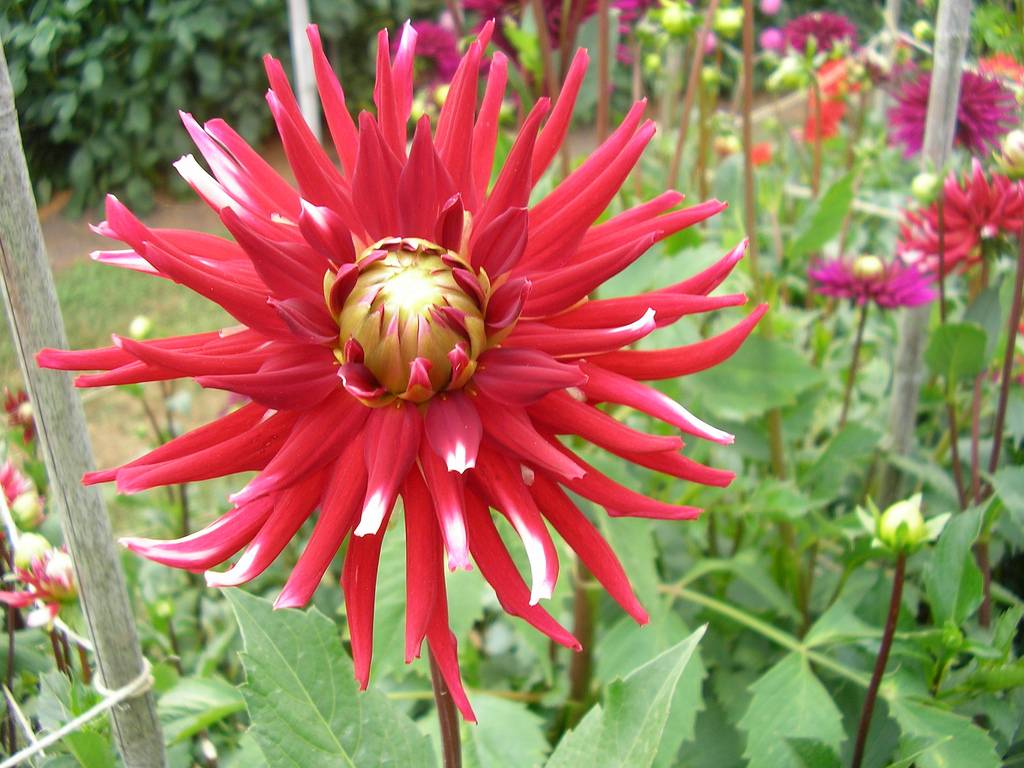
- Subscribe!
- Contents































